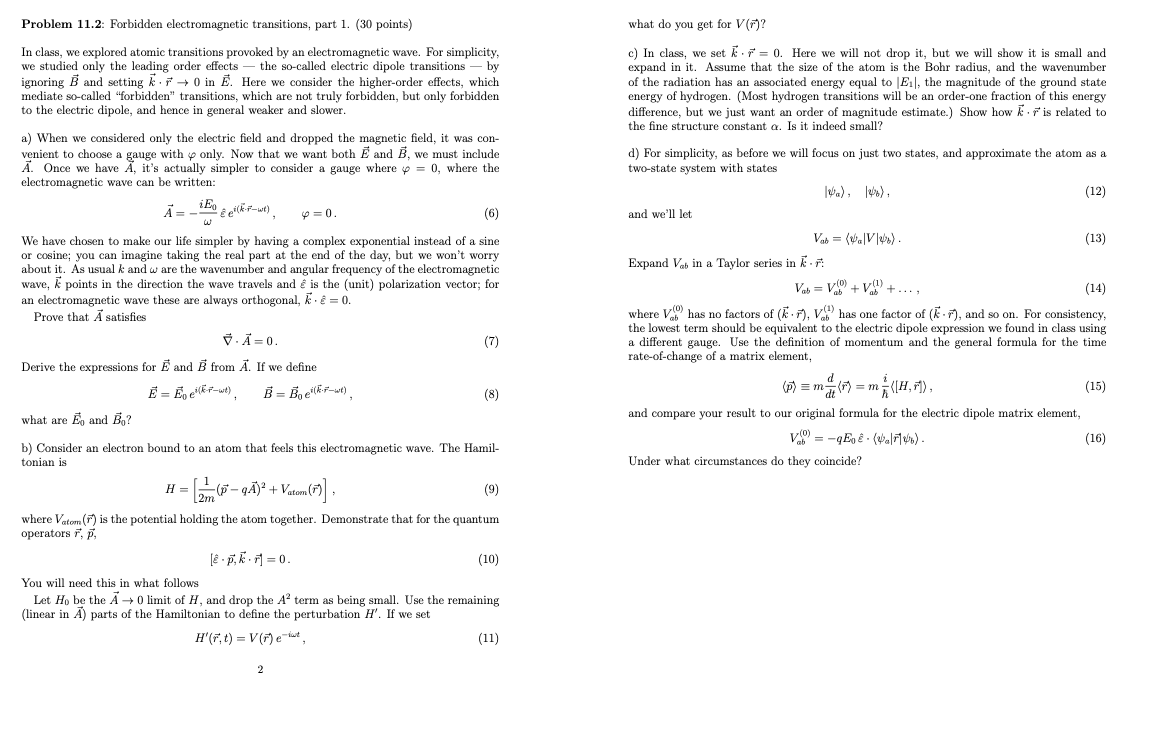Answered step by step
Verified Expert Solution
Question
1 Approved Answer
Problem 11.2: Forbidden electromagnetic transitions, part 1. (30 points) In class, we explored atomic transitions provoked by an electromagnetic wave. For simplicity, we studied

Problem 11.2: Forbidden electromagnetic transitions, part 1. (30 points) In class, we explored atomic transitions provoked by an electromagnetic wave. For simplicity, we studied only the leading order effects the so-called electric dipole transitions - by ignoring Band setting 0 in E. Here we consider the higher-order effects, which mediate so-called "forbidden" transitions, which are not truly forbidden, but only forbidden to the electric dipole, and hence in general weaker and slower. a) When we considered only the electric field and dropped the magnetic field, it was con- venient to choose a gauge with only. Now that we want both E and B, we must include A. Once we have A, it's actually simpler to consider a gauge where = 0, where the electromagnetic wave can be written: what do you get for V (F)? c) In class, we set = 0. Here we will not drop it, but we will show it is small and expand in it. Assume that the size of the atom is the Bohr radius, and the wavenumber of the radiation has an associated energy equal to Eil, the magnitude of the ground state energy of hydrogen. (Most hydrogen transitions will be an order-one fraction of this energy difference, but we just want an order of magnitude estimate.) Show how E. is related to the fine structure constant a. Is it indeed small? d) For simplicity, as before we will focus on just two states, and approximate the atom as a two-state system with states = iE(), 4=0. (6) and we'll let Va), 3), Vab = (a|V|%). (12) We have chosen to make our life simpler by having a complex exponential instead of a sine or cosine; you can imagine taking the real part at the end of the day, but we won't worry about it. As usual k and w are the wavenumber and angular frequency of the electromagnetic wave, points in the direction the wave travels and is the (unit) polarization vector; for an electromagnetic wave these are always orthogonal, . = 0. Prove that A satisfies V. A=0. Derive the expressions for E and B from A. If we define E = E(--) what are and Bo? B = Be(wt) (7) (8) Expand Vab in a Taylor series in Vab=V(0)+V(1) +.... (13) (14) where V has no factors of (F), V has one factor of (F), and so on. For consistency, the lowest term should be equivalent to the electric dipole expression we found in class using a different gauge. Use the definition of momentum and the general formula for the time rate-of-change of a matrix element, d (p) = m (r) = m ([H, r]), and compare your result to our original formula for the electric dipole matrix element, (15) b) Consider an electron bound to an atom that feels this electromagnetic wave. The Hamil- tonian is H = 2m (p q) + ` + Vatom (P)]; V(0) ab (9) Under what circumstances do they coincide? ' = qo (a||6). where Vatom (F) is the potential holding the atom together. Demonstrate that for the quantum operators F, p, [. p,k.r]=0. You will need this in what follows (10) Let Ho be the A 0 limit of H, and drop the A term as being small. Use the remaining (linear in A) parts of the Hamiltonian to define the perturbation H'. If we set H'(r,t) V(r)et, (11) 2 (16)
Step by Step Solution
There are 3 Steps involved in it
Step: 1

Get Instant Access to Expert-Tailored Solutions
See step-by-step solutions with expert insights and AI powered tools for academic success
Step: 2

Step: 3

Ace Your Homework with AI
Get the answers you need in no time with our AI-driven, step-by-step assistance
Get Started


